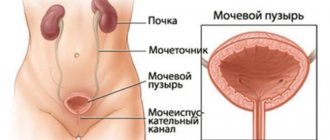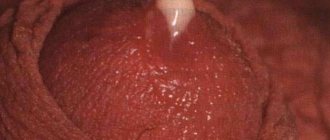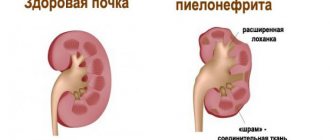Characteristics of the pathogen
The causative agent of chlamydia, chlamydia (Chlamydia trachomatis), is a gram-negative bacteria with a round shape. Chlamydia affects the urinary and reproductive systems and has the ability to penetrate the intestines, causing disturbances in the intestinal biocenosis. Due to the lack of the ability to independently synthesize ATP, bacteria can only exist inside the cells of a living organism, and most often affect the columnar epithelium. They reproduce by division. Chlamydia have an antigen specific to their group, which makes it possible to detect bacteria using the immunofluorescent method.
Rice. 2. The development cycle of chlamydia.
The development cycle of chlamydia inside cells ranges from 40 to 72 hours. Pathogens have the ability to activate healthy cells to capture them, and inside the cells they interfere with their destruction. Outside the cell, chlamydia exists in the form of elementary bodies. Inside the cell, the elementary body turns into a reticular body, where it grows, develops and multiplies
Bacteria show sensitivity to antibiotics only during the reproduction period, that is, in the phase of development of reticular bodies. Chlamydia in the form of elementary bodies can exist in the intercellular space for a long time. Unfavorable factors can affect the transformation of chlamydia into L-forms, which develop resistance to antibiotics and pass on the newly acquired quality to daughter cells. The causative agents of chlamydia are difficult to identify when cultured on special media.
In the external environment, Chlamidia trachomatis exhibits high resistance, including to low temperatures and drying. At room temperature they die only after 24–36 days. Bacteria are quickly killed by boiling. They are sensitive to the action of some antibiotics, antiseptics and ultraviolet radiation. Chlamydia of the species C. psittaci remain viable in the external environment for up to 3 weeks. Pathogens of the species Chlamydia trachomatis cause diseases only in humans. They cause diseases such as urogenital chlamydia, trachoma, paratrachoma, lymphogranuloma venereum pneumonia, synovitis, arthritis, conjunctivitis and proctitis.
Pathogens of the species Chlamidia psittaci cause bird disease (ornithosis), keratoconjunctivitis and abortions in sheep. Pathogens of the species Chlamidia pneumonia cause pneumonia, acute respiratory infections, bronchial asthma, vasculitis and endocarditis.
Rice. 3. The causative agent of chlamydia Chlamydia trachomatis inside the epithelial cells of the conjunctiva of the eye.
https://youtu.be/-3dZAy3VP-U
Source and routes of transmission of infection
- The disease is transmitted sexually through unprotected oral, vaginal and anal sex, as well as through vibrators and sex toys of the patient. The source of infection is infected semen and vaginal fluid.
- Contact and household transmission of infection is rarely recorded.
- From an infected pregnant woman to a newborn during childbirth, the infection is transmitted in 15 - 50% of cases. The number of infected pregnant women is quite large and ranges from 10 to 40%. In the case of a burdened gynecological history, this figure approaches 63%.
Why does discharge occur with varying degrees of intensity?
Discharge in women and men, namely their quantity and characteristics, depend on:
- state of the human immune system;
- specific location of the lesion;
- duration from the moment of infection - acute or chronic stage;
- period of illness - exacerbation or remission.
For your information. The source of chlamydial infection is a man or woman with any, both manifest and asymptomatic, form of the disease, at any stage and period of its course. Parasites are transmitted through genital, genital-oral and genital-anal sexual intercourse.
Household infection with chlamydia is theoretically possible, but in practice it does not occur
Chlamydia is “insidiously” different from other sexually transmitted infections.
When tissues are infected with chlamydia, parasitism in human cells does not occur in one way, but can be realized in two ways:
- Cytoid mechanism. It is characterized by the formation of secretions (exudates) of varying degrees of intensity, as well as other characteristic symptoms of the inflammatory process: swelling and redness of the mucous membrane, itching, burning, pain. In some cases, papules form on the epithelium.
- Persistent mechanism . In this case, chlamydia, after penetrating human cells, multiplies in moderate quantities and at an extremely low speed. At the same time, the human cell, which has become an “incubator” for the parasite, does not die for a long time and retains the ability to reproduce. The resulting daughter cells can be either infected or free from chlamydia. In this case, the disease proceeds without the release of exudates, as well as other typical signs and manifestations.
How the disease develops
During this time, bacteria actively multiply.
- The disease begins with infection of the mucous membrane of the cervical canal of the uterus. The infection quickly spreads to the urethra and can affect the Bartholin's glands.
- With retrograde spread of infection in women, the uterus, fallopian tubes, ovaries and abdominal cavity are affected. The source of infection is not only the secretion from the sick partner, but also his infected sperm. In this case, the sperm enter the uterus directly. This leads to the development of chlamydial endometritis.
- Abortions and the presence of uterine devices contribute to the spread of infection.
- Abortions and some other operations contribute to the spread of infection from the lower parts of the urogenital tract to the upper ones.
- During perverted sexual intercourse, gonorrheal inflammation develops in the rectum and pharynx.
- Chlamydia can spread through the lymphatic tract and blood.
Discharge after treatment
Therapy with strong antibiotics, which is prescribed for this infection, usually gives a positive result. However, there are situations when not all affected cells are killed and the activity of pathogenic microorganisms does not subside. You can notice a similar phenomenon if, after treatment of chlamydia, characteristic discharge remains.
They usually appear during or immediately after urination. The first thing to do in this case is to consult your doctor. Repeated examination will allow you to accurately determine the presence of infection in the body. Tests are recommended to be done at the end of therapy: after about a month.
Pathological discharge and other symptoms remaining after treatment may indicate the following phenomena:
- Changes in microflora under the influence of antibiotics - aggressive therapy usually destroys not only pathogenic microorganisms, but also beneficial ones, which are taken into account by the doctor when prescribing drugs, i.e. the specialist additionally prescribes medications that normalize the microflora on the mucous membrane.
- Ineffectiveness - the disease did not respond to treatment with prescribed drugs, the patient may not have completed the therapeutic course completely, or the chosen prescription was drawn up without taking into account the form and nature of the disease in a particular case.
- During the examination, we did not notice the presence of a secondary infection, which continues to affect the body, which affects the appearance of pathological discharge.
- Treatment was prescribed to only one partner - in such a situation the disease simply recurs.
When the course of treatment has been completely completed by both partners, it is recommended to abstain from sexual activity for a month. During this period, women should actively restore the vaginal microflora with the help of specially selected medications and probiotics in order to populate it with beneficial bacteria. The appearance of any alarming symptoms should be reported to your doctor.
Symptoms and signs of chlamydia in women
Up to 70% of women with the disease do not experience any discomfort. Chlamydia in women has a sluggish course. Symptoms of the disease are often not expressed. Chlamydia affects the lower and upper parts of the urogenital tract.
Chlamydial colpitis
Inflammation of the vagina with chlamydia is rare. Basically, such a pathology develops with pathological
Chlamydial cervicitis
The most common manifestation of chlamydia in women. There is a mucopurulent discharge, not abundant, with an unpleasant odor. On vaginal examination, swelling of the cervix and an inflammatory halo around it with areas of maceration are noted. Chlamydial cervicitis often causes premature birth. Rupture of the membranes of the fetus leads to infection of its lungs and digestive tract.
Chlamydial urethritis and paraurethritis
Urethral syndrome affects about 40% of women. The disease is characterized by frequent urge to urinate, pain and burning during urination. When diagnosing chlamydia, taking urethral swabs will increase the likelihood of detecting chlamydia in women with the disease.
Chlamydial bartholinitis
Chlamydial inflammation of the Bartholin glands is manifested by hyperemia in the gland area, compaction of surrounding tissues and pain.
Signs and symptoms of chlamydia in some organs
Chlamydia can infect the rectum, throat, and eyes.
- The rectum is affected during unprotected anal sex. The patient is bothered by discharge from the rectum and a feeling of discomfort.
- Chlamydial infection of the throat occurs during unprotected oral sex. The disease rarely causes any symptoms.
- Infected semen and vaginal discharge can get into the eyes and further develop chlamydial conjunctivitis. The patient is concerned about redness of the eye, pain and purulent discharge.
Chlamydial endometritis
If the uterus is damaged, there are complaints of frequent pain in the lower abdomen and pain after intercourse. The discharge becomes mucopurulent in nature and has an unpleasant odor. Sometimes bleeding occurs during sex and bleeding between monthly cycles. The disease almost always occurs with simultaneous chlamydial damage to the fallopian tubes and ovaries.
Chlamydial salpingitis and oophoritis
- the most common complication of chlamydia in women. The disease is characterized by a long-term, low-symptomatic or asymptomatic course that is not prone to worsening. The main symptoms are pain in the lower abdomen. The menstrual cycle is disrupted. In the acute period, low-grade body temperature is noted.
Chlamydial salpingoophoritis is complicated by a terrible pathology - the development of severe adhesive infertility, miscarriage and adhesive disease, which manifests itself as chronic pain in the lower abdomen.
Up to 70% of all cases of chlamydia in women are asymptomatic. Delay in seeking medical help affects a woman’s reproductive function
Rice. 4. Type of mucous discharge due to chlamydia.
Rice. 5. Vaginal discharge due to chlamydia.
Rice. 6. Inflammation around the pharynx of the cervical canal.
Rice. 7. Chlamydial conjunctivitis.
Discharge from “male” chlamydia
In men, Chlamydia trachomatis, once inside the urethra, first of all “occupies” its navicular fossa, which is located approximately 3.5-4 cm from the entrance. When the disease becomes chronic, damage occurs to the prostate gland, seminal vesicles, vas deferens and epididymis.
Table 3 - Characteristics of discharge in men depending on the location of chlamydia:
On a note. Many people are interested in the question - What is the smell of chlamydia discharge? The whitish, mucous exudate does not have any unpleasant odor, but the appearance of a “fishy” odor is accompanied by the appearance of pus in the discharge. The more intense the color of the exudate, the stronger the bad aroma.
Complications of chlamydia in women
- Chronic inflammatory disease of the cervix, pelvic organs, and abdominal organs is a serious complication of chlamydia in women. Multiple adhesions cause the development of pregnancy pathology and infection
- The adhesive process leads to chronic pain in the pelvic area.
- Salpingoophoritis is complicated by pelvioperitonitis - inflammation of the pelvic peritoneum. The acute phase of the disease occurs with high body temperature and severe pain in the lower abdomen. As the disease moves into the chronic phase, the severity of clinical symptoms smoothes out.
- When the infection spreads to the upper abdominal cavity, severe pain appears in the right hypochondrium, which indicates damage to the liver capsule (Fitz-Hugh-Curtis syndrome). The development of a powerful adhesive process leads to chronic pain in the upper abdominal cavity.
- A protein has been found in some chlamydia. Such patients develop Reiter's syndrome, in which inflammation of the vagina is combined with reactive arthritis of one or more joints and. The syndrome develops 20 times more often in men.
Chlamydia in women often occurs with mild symptoms and takes on a chronic form with a minimum number of external manifestations, having a significant impact on the human reproductive system.
Rice. 8. Chlamydia in women. Adhesions in the pelvis.
Rice. 9. Chlamydia in women. Adhesions in the pelvis.
Rice. 10. Chlamydia in women. Adhesions in the pelvis.
Rice. 11. Chlamydial conjunctivitis in a newborn.
Rice. 12. Reiter's syndrome with chlamydia.
Diagnosis of chlamydia
Chlamydial infection is diagnosed according to the same principles as other infections. To test for chlamydia, discharge from the cervical canal of women and the urethral canal of men is used. Urine sediment can be used for testing. When taking a smear from the cervix, a special brush is used. The procedure takes place from the cervical canal.
Chlamydia is often found with pathogens of other diseases that are sexually transmitted - gonococci, mycoplasmas, trichomonas and ureplasmas due to the same route of transmission.
Molecular biological methods
Chlamydial DNA diagnostics (PCR) is a highly sensitive technique. Its specificity reaches 80 – 100%. greatly simplifies the research.
Culture diagnostic method
and allows the detection of viable bacteria. However, its sensitivity is low and amounts to 40 – 60%. In addition, the technique is quite labor-intensive and time-consuming. But the delivery of material to bacteriological laboratories and its storage have certain limitations.
Direct immunofluorescence method (DIF)
The results of the study depend on the quality of the material obtained and the qualifications of the laboratory personnel. Quick results are a clear advantage of this method.
Bacterioscopic method
To carry out this method, it is necessary to have a scraping of the affected mucosa, since chlamydia multiplies intracellularly, where they are located in the form of reticular bodies.
Serological methods
Serological methods are not recommended for diagnosing chlamydia in the Russian Federation.
If you are young and sexually active, get tested for chlamydia infection once a year or whenever you change sexual partner.
Rice. 13. In scrapings from the conjunctival epithelium, intracellular inclusions of pathogen bodies are visible.
Treatment of chlamydia in women
Chlamydia in women can be easily cured with antibiotics. But the problem is that in half of the patients the disease is asymptomatic and treatment begins late in the development of complications of the disease. Treatment of chlamydia in women is complex. It is aimed at combating the pathogen, increasing immunity and preventing the development of dysbacteriosis and candidiasis.
Antibacterial therapy
The causative agents of chlamydia are highly sensitive to tetracycline antibiotics (doxycycline), azithromycin, rifampicin, josamycin and fluoroquinolones (levofloxacin). Doxycycline and azithromycin are the most commonly prescribed antibiotics for chlamydia. Chlamydia shows sensitivity to antibiotics only during the reproduction period, that is, in the phase of development of reticular bodies, when the pathogen is intracellular. Chlamydia in the form of elementary bodies can exist in the intercellular space for a long time. Unfavorable factors can affect the transformation of chlamydia into L-forms, which develop resistance to antibiotics and pass on the newly acquired quality to daughter cells.
Antibiotics from the macrolide group are especially effective against intracellular bacteria. Tetracycline drugs are also quite effective in the treatment of chlamydia and have been the mainstay in the treatment of this disease for a long time. However, long-term use of these antibiotics requires great self-discipline from the patient and increases the risk of side effects. Treatment of chlamydia should be carried out with antibiotics: azithromycin once or doxycycline for 7 days. The effectiveness of treatment of chlamydia in this case reaches 97%. Alternative drugs include the antibiotics erythromycin, ofloxacin, roxithromycin and clarithromycin, which are given for 7 days. For chlamydia in pregnant women
If, after the prescribed course of treatment, a culture of biological material done 2 weeks after the end of treatment gives a positive result, then a second course of other antibiotics is prescribed. The chronic form of chlamydia is more effectively treated with short courses with breaks. Long continuous courses suppress the immune system and contribute to the development of dysbiosis and candidiasis.
Prevention of candidiasis
To prevent candidiasis, nystatin, levorin, nizoral or fluconazole are used.
Prevention of dysbacteriosis
Prevention of dysbacteriosis is carried out throughout the course of antibiotic therapy and for another 10 days after its completion. It is recommended to use bifidumbacterin, lactobacterin and other eubiotics.
Immunity correction
Polyoxidonium, cycloferon, etc. are used to correct immunity.
Local treatment
For maceration of the mucous membrane of the cervix, local treatment with disinfectants and healing agents is indicated.
- It is forbidden to have sex until the end of treatment for chlamydia.
- It is recommended to screen sexual partners with whom you have been in contact for the past six months for the presence of the disease.
Do not self-medicate. Only a doctor will prescribe the correct treatment for chlamydia and determine whether there is a cure. Self-medication leads to the development of resistant strains of the pathogen and the transition of the disease to a chronic form.
Rice. 14. Chlamydia in women. Dissection of adhesions in the pelvis.
Rice. 15. Chlamydia in women. Dissection of adhesions in the pelvis.
What happens after treatment?
If women have discharge after treatment for chlamydia, and two repeated PCR studies (1.5 and 3 months after treatment) confirm the absence of chlamydial parasites, as well as other viruses or bacteria, then they are considered normal, provided they meet the following criteria:
- The average volume is about a teaspoon per day. It is possible that the production of secretions may increase or decrease depending on changes in the emotional state, excessive physical exertion, sudden weight loss or weight gain, due to diseases of the thyroid or pancreas.
- Consistency and color. The gynecological protocol instructions describe these discharge norms as follows:
- after critical days - scanty, white, similar to liquid soap;
- “near” ovulation – transparent, viscous, reminiscent of egg white;
- after ovulation, cloudiness and liquefaction occurs - like milk;
- before menstruation - small lumps may appear.
- Smell. The aroma is absent or similar to sour milk.
For your information. Taking contraceptives may affect the above-mentioned cyclical changes in the characteristics of vaginal discharge. Throughout the entire period, the discharge may resemble diluted milk.
Men may also experience discharge after treatment for chlamydia.
These are the usual ones:
- smega or “sebum” is a white mixture of the secretion of the glands located at the foreskin with desquamated epithelium;
- libidinal urethrorrhea - clear mucus secreted from the urethra during erection of the penis.
If there are other types of discharge flowing from the urethra, then the treatment for chlamydia was not effective or there are other diseases of the genitourinary system.
By watching the final video in this article, you can “get acquainted” in more detail with these unique human urogenital parasites - Chlamydia trachomatis.
Source: ZPPP.su










